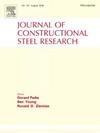单面弹性复合梁柱连接实验研究
IF 4
2区 工程技术
Q1 CONSTRUCTION & BUILDING TECHNOLOGY
引用次数: 0
摘要
本文介绍了对单侧弹性复合梁柱连接的实验研究,其中在顶部和底部翼缘分别安装了不可更换的混凝土板和连接板以及可更换的屈曲约束盖板(BRCP)。考虑到混凝土板的影响,对拟议接头的抗震性能和可更换性进行了研究。一个试件在 2% 的旋转下循环加载,然后更换损坏的 BRCP 核心板,形成一个新的试件,在 4% 的旋转下循环加载。结果表明,中性轴向上移动到了上翼缘,这使得损坏集中在芯板上,而连接板和混凝土板在 2% 的旋转下仅发生了轻微损坏。在旋转 2% 的情况下,更换后的滞后曲线与更换前基本相同;在旋转 4% 的情况下,滞后曲线显示出完整而稳定的循环,承载能力没有下降,这意味着该接头具有良好的抗震性能和可更换性。此外,还将拟议的接头与裸钢接头进行了比较,以考察混凝土板的影响。此外,还开发了试件的数值模型,并通过与试验结果的对比进行了验证,以更好地理解试验并研究连接板的影响。最后,推导出了连接处的屈服力矩和初始刚度公式,并与试验结果进行了对比,以验证公式的准确性。利用公式讨论了核心板面积减小对连接刚度和中轴位置的影响。本文章由计算机程序翻译,如有差异,请以英文原文为准。
Experimental study on a single-sided resilient composite beam–column joint
This paper presents an experimental study on a single-sided resilient composite beam–column joint, in which a nonreplaceable concrete slab and connection plate and a replaceable buckling-restrained cover plate (BRCP) are installed at the top and bottom flanges, respectively. The seismic performance and replaceability of the proposed joint were investigated considering the influence of the concrete slab. One specimen was cyclically loaded under 2 % rotation, and then the damaged core plate of the BRCP was replaced to form a new specimen that was cyclically loaded under 4 % rotation. The results showed that the neutral axis was shifted upward to the top flange, which made the damage concentrate in the core plate, and only minor damage occurred to the connection plate and concrete slab under 2 % rotation. The hysteresis curve after replacement was almost the same as that before replacement under 2 % rotation and showed full and stable loops without decrease in load capacity under 4 % rotation, implying good seismic performance and replaceability. In addition, the proposed joint was compared with a bare steel joint to examine the effects of concrete slabs. Further, a numerical model of the specimen was developed and verified by comparison with the test results to better understand the test and study the influence of connection plates. Finally, the formulas for the yield moment and initial stiffness of the joint were derived and compared with test results to verify the accuracy of the formulas. The influence of the reduction in core plate area on the joint stiffness and neutral axis position was discussed using the formulas.
求助全文
通过发布文献求助,成功后即可免费获取论文全文。
去求助
来源期刊

Journal of Constructional Steel Research
工程技术-工程:土木
CiteScore
7.90
自引率
19.50%
发文量
550
审稿时长
46 days
期刊介绍:
The Journal of Constructional Steel Research provides an international forum for the presentation and discussion of the latest developments in structural steel research and their applications. It is aimed not only at researchers but also at those likely to be most affected by research results, i.e. designers and fabricators. Original papers of a high standard dealing with all aspects of steel research including theoretical and experimental research on elements, assemblages, connection and material properties are considered for publication.
 求助内容:
求助内容: 应助结果提醒方式:
应助结果提醒方式:


